In a rare move, a sleepy cataclysmic variable blows its top and suddenly becomes a nova.
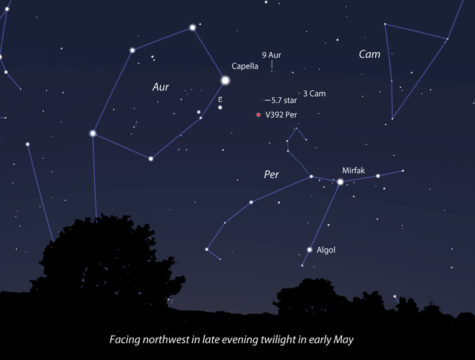
Stellarium
The dwarf nova V392 Persei, which only gets as bright as magnitude 14 during outburst, appears to have undergone a rare nova outburst. The sudden and steep brightening was discovered photographically on April 29th by Yuji Nakamura of Japan, who recorded the star at magnitude 6.2. Spectra obtained shortly thereafter with the 2.4-meter Hiltner telescope on Kitt Peak confirm the explosion as a nova.
Had the Moon not brightened the sky, the outburst would have been visible with the naked eye from a dark site.
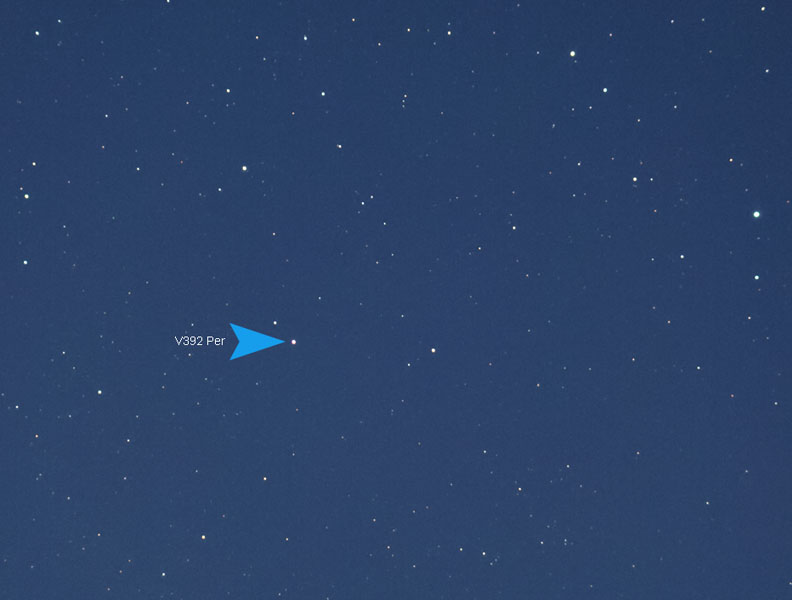
Will Gater
As of this morning, May 1st, V392 Per has faded a magnitude to 7 and remains an easy catch in binoculars. There's no telling whether it will brighten further, continue to fade, or hit a standstill. One thing is certain: dwarf novae rarely explode as novae. This is something very special, and I encourage you to grab your binoculars for a look.
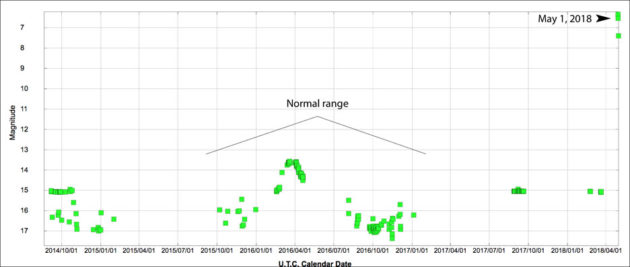
AAVSO
Dwarf novae are binary stars where the more massive star, a white dwarf, robs matter from a closely-orbiting lower mass companion. As the material spins into an accretion disk around the dwarf, variations in its flow and temperature cause the disk to periodically heat up and brighten. Through a telescope, the star swells 2 to 6 magnitudes in just a day or two. Catching one on the rise after seeing it at minimum for weeks is one of the more exciting sights in amateur astronomy.Two of the most famous dwarf novae are U Geminorum in the winter sky and SS Cygni in the summer.
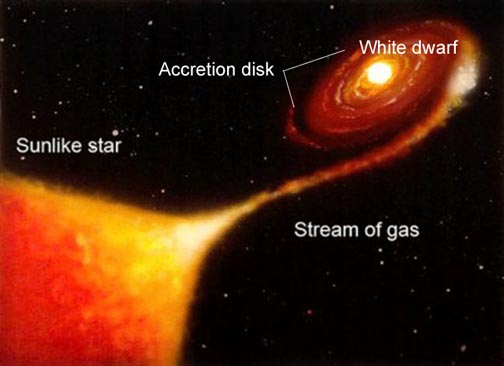
NASA
Only once in the history of dwarf novae observations has a star (V1213 Cen) transitioned to a nova. In a nova, material from the disk gets dumped onto the surface of the white dwarf, where it's compressed and heated to ignite in a much more powerful (and brighter) explosion. V392 Per shot up nearly 9 magnitudes and may brighten even more. Eruptions like this are predicted to recur on timescales of 10,000 to 1 million years.
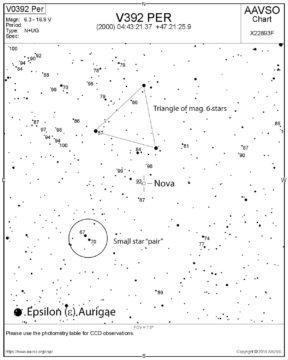
AAVSO
You can stay in touch with the nova's daily behavior by going to the AAVSO website and typing in the star's name in the Pick a Star box. Then, select a link to either review recent observations, make a new light curve, or create a chart.
Use the accompanying AAVSO chart (and/or this more detailed chart) to find the star and estimate its brightness. Start at Epsilon (ε) Aurigae, the star at the apex of the skinny triangle that forms "The Kids" asterism near Capella, then star-hop to the northwest past the "star pair" on the map to the nova.
In both charts, you'll notice a 9.3 magnitude star close to and nearly due east of the nova. It's a nice comparison star to help in seeing the nova's changing brightness over the coming nights. Click to enlarge, download, and print each. North is up in both. Clear skies!
** Update: I estimated V392 Per at magnitude 8.3 on May 2.12 UT. Several people have asked me how far away the nova is. Using the star's parallax from the most recent GAIA data release, it's about 12,700 light years away.
 14
14









Comments
Tom-Reiland
May 1, 2018 at 3:26 pm
Bob, I observed it Sunday night and estimated it at 6.5 magnitude. I tried it again last night, but I only got brief glimpses of it from my light polluted neighborhood, plus the Moon was a problem both nights. I "guessed" that it was close to 7.5 mag last night with my 10 X 5o binocs. John Bortle wrote in the AAVSO page that this was the first time he ever remembered seeing a Dwarf Nova become a classic Nova. This is why many of us love observational Astronomy. The surprises and unusual events.
You must be logged in to post a comment.
Bob KingPost Author
May 1, 2018 at 4:01 pm
Tom,
You're lucky to have caught it so bright. I'm looking forward to seeing it first time tonight (we've had clouds). Like you I love surprises.
You must be logged in to post a comment.
Tom-Reiland
May 2, 2018 at 1:39 am
I was able to view it again tonight, but this time at Wagman Observatory before Moonrise. It was visible in all optics from my 10 X 50s to the 21" Newtonian at 127X. When I first saw it at 9:30 PM EDLT, I estimated it at 7.9 mag, but when I went back to it 25 minutes later it appeared to be 0.1 to 0.2 magnitude fainter using the 9.3 mag star next to it. I didn't know if it was my imagination or if it had actually faded in that short period of time. I'll probably have to wait two or three nights to get another look at it.
You must be logged in to post a comment.
Bob KingPost Author
May 2, 2018 at 9:41 am
Tom,
I got about 8.3 last night. Fading still but a must-see object every night. There may still be surprises in store.
You must be logged in to post a comment.
Tom-Reiland
May 3, 2018 at 2:27 am
Bob,
Using the chart you posted, I estimated V392 Per at 8.5 mag in comparison with the 8.4 mag star North of it and the 8.7 star to the South at 1:45 UT May 3. It's faded more than 2 magnitudes since the discovery and 2 mag since I first observed it Sunday. Clouds are moving in here and rain and storms will soon follow. Next good chance won't be until Saturday at the earliest, but the best guess is Sunday or Monday in Western Pa.
You must be logged in to post a comment.
Raymond
May 2, 2018 at 1:49 am
Hi Bob, thanks for great article as always.
I caught it night of Apr 30, estimated mag 7.3. Then tonight May 1, estimated mag 8.0. There is a 9.3 mag star about 4' east, soon they may be a matching pair.
You must be logged in to post a comment.
Bob KingPost Author
May 2, 2018 at 9:43 am
I appreciate that Raymond. Very handy having that 9.3 mag. star right next store 🙂
You must be logged in to post a comment.
Michel Deconinck
May 2, 2018 at 4:52 am
Hi Bob and thank you for the great quality and interest of all your articles.
Thanks to the AAVSO alert I was able to estimate visualy this event just at the exact maximum time.
That was April 29th 19:58 UTC, I just post a sketch of the observation in your gallery.
In your curve here before I see only CCD estimations (only green dots) but no pure visual estimations (black dots) as mine correct ?
Michel - DMIB
You must be logged in to post a comment.
Bob KingPost Author
May 2, 2018 at 9:42 am
Hi Michel,
Thank you for your kind words and for sharing your sketch.
You must be logged in to post a comment.
phoralek
May 3, 2018 at 8:20 am
Captured over (ESO) Supernova... so literally nova and supernova in one image 🙂
https://www.astronom.cz/horalek/?p=3877
You must be logged in to post a comment.
Bob KingPost Author
May 3, 2018 at 10:46 am
Hi Phoralek,
A nice catch - do you know which supernova that is and it's approximate angular distance from the nova?
You must be logged in to post a comment.
Joe Stieber
May 3, 2018 at 8:26 pm
Bob,
The “Supernova” is the name of the foreground planetarium in Garching, Germany.
You must be logged in to post a comment.
Bob KingPost Author
May 3, 2018 at 9:20 pm
Hi Joe,
Ahhhhh ... 🙂
You must be logged in to post a comment.
Yash
June 20, 2018 at 1:52 am
It was amazing thank you for informing I saw it at roughly 7mag
You must be logged in to post a comment.
You must be logged in to post a comment.